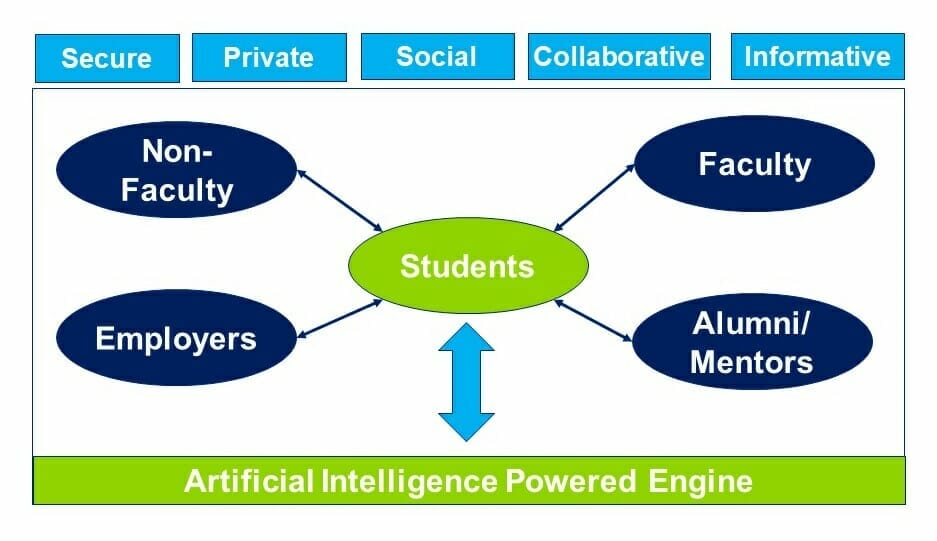
Our campus communities — students, faculty, staff, alumni — deal with information overload across many platforms and apps. Isn’t it time we brought campus communication and learning into one high-tech ecosystem?
Editorial by Kathy Edersheim (President, Impactrics LLC) and Yasim Rahman (CEO, Unio)
Today, while we all deal with massive information overload, this is an acute problem for students. Simply by carrying a smartphone, students are bombarded with information almost constantly. And, as mentioned in a recent Nielsen study, 98% of students from age 18-24 own a smartphone. Millennials wake up with their phones, sleep with their phones, take their phones to their bathrooms and, yes, some check it during sex. (See this study on smartphone separation anxiety.) The massive data deluge leads to information overload, confusion, and a general lack of focus and attention.
Colleges need to do whatever they can to simplify navigation of the educational experience to foster a positive experience and successful completion. It is shocking that only about 60% of high school graduates who started college in 2009 finished within six years – by 2015 – and that challenges in coping with college were a key factor.
Where does all the information – and information overload – come from? Students (and alumni!) have a myriad of apps and functionalities on their phones vying for their attention. For a typical student, a small sample might include:
- Social Media – You Tube, Snap Chat, Facebook, Twitter, Pinterest, and Instagram
- Chat platforms – Facebook Messenger, WhatsApp, SMS, FaceTime
- Email – Personal emails and college email through gmail, outlook, yahoo, etc.
- Learning Management Systems (LMS) products – Canvas, Blackboard or other college related LMS.
- Gaming Apps and Sites – College students are avid gamers and half of them skip studying to play games. WHO is planning to recognize “gaming disorder” as a mental health condition in 2018.
Colleges compound the problem of apps and platforms competing for students’ attention by distributing massive amounts of information relating to a wide range of topics of varying importance across multiple channels and platforms. In doing this, not only do colleges add to the onslaught of information—sometimes conflicting information; they also miss the opportunity to bring all of these communications into a single ecosystem and by doing so, connect students across campus with faculty, administrators, and alumni on one seamless platform. We also know that alumni wish deeply to be connected with the faculty, that many faculty members want to be more connected with each other to share research and pedagogical techniques and resources across departments, and that students often arrive at their college or university seeking experiences that will connect them with a larger learning and social community.
Colleges need to streamline their communications and find the students, faculty, and alumni where they are: on their phones. While some colleges have upgraded their technical infrastructure and now provide a mobile platform to address some of the communication needs, there are multiple mobile apps or web sites that students must comb through to gather the required information and the user experience tends to be poor. Because the apps provide scattered functions and aren’t integrated, they add to the confusion as well as the overload of information.
What we need is an integrated ecosystem.
Why Don’t We Have Such an Ecosystem Already?
Here are the top three reasons why a comprehensive ecosystem like this doesn’t exist:
- There are a myriad of platforms and apps that deal with each aspect of Higher Ed ranging from admissions, orientation, campus activities, learning management systems (LMS) to placements, online learning and alumni communities. As individual departmental needs were met, administrative areas have not been motivated to collaborate and therefore have adopted siloed software systems.
- It is costly and technically challenging to integrate and merge existing systems that manage student, faculty, and alumni data that would support the necessary breadth of functionality for a college.
- The perception that there is no urgent need – at least not yet!
What Would a Higher Tech Ecosystem Do – And Look Like?
Colleges need to have a mobile platform that is private, secure, informative, collaborative, and engaging. It is worth emphasizing that it must have the social media features required to keep the students engaged. The comprehensive ecosystem might be the educational equivalent of a collaborative community platform like Slack.
Such a private and secure college community would incorporate:
- Communications among community members
- Course registration
- Course information (assignments, etc)
- Extra-curricular opportunities – schedules and information
- Facilities information
- Travel abroad opportunities
- Internship opportunities
- Career strategies
- Alumni platforms
While it might seem like a replication of the college website, it would actually do much more. It would enable academic/lifestyle success coaches, mentors and advisers to identify and talk to the students (and alumni) in need of support and help them navigate the social, cultural and academic challenges they face in college and beyond. The types of interaction and the frequency of interaction between students and other stakeholders will strengthen the entire network. This is especially crucial for first generation college students who may lack guidance from their parents or others. This integrated system will also improve the retention and graduation rates at colleges as struggling students get the support they need to persist and complete their course of study successfully.
 From Information Overload to Collaborative Learning:
From Information Overload to Collaborative Learning:
A Conceptual Model for a High Tech, Higher-Ed Ecosystem by Yasim Rahman
As an inclusive community, the ecosystem would provide students with access to the powerful resource of the alumni body as well as allowing for alumni-to-alumni interaction. With proper utilization and facilitation through the ecosystem, students could find alumni mentors and advisors based on their job location, job title, companies, and interests. Alumni would be able to volunteer their services to students and other alumni who want to reach out to them. In this element, the technology would be the educational institution equivalent of LinkedIn.
As the consolidated ecosystem collects all aspects of college data (student, alumni and faculty data), the potential for a better system using Artificial Intelligence (AI) is enormous. Because of the ways it would identify patterns and facilitate the sharing of resources, contacts, learning, and information across different departments and communities within the larger campus community, AI could further enable colleges to improve their retention, graduation and job placement rates and perhaps expand the career possibilities for students and alumni. There are a few schools experimenting with providing Alexa or similar forms of technology to each student as a centralized information source. The intention is to better understand student questions and need for information as well as to provide information in an easily accessible way.
Summary
We are living in a world where technology is delivering innovative breakthroughs. Driver-less cars and Artificial Intelligence robots are soon going to be a reality. An integrated learning and life-skills education model is crucial to provide students with the tools they need for success through a full range of possibilities.
The technology solutions to support this need present what is ultimately a change management problem. Many departments will need to let go of their traditional “powers” and collaborate with other units to provide a seamless experience for students, faculty, and alumni while protecting the security and privacy of users. With the innovations in education and the rapidly developing technology available to us, the time is ripe for this change.
So, are you ready to bring high tech to higher ed? Here are a few critical questions to get you started:
- What connections and resources, internal and external, does your IT department need to design a new high tech ecosystem?
- Who at your institution might be a champion of such an ecosystem?
- Who at your institution might be resistant to it?
- What should be your first conversation (or step) to explore the strategy?
- Are there are opportunities to collaborate with other institutions to build the system?
- Are there opportunities to collaborate with tech companies to build the ecosystem?
Please let us know what you think by dropping us an email.
Contact the Authors
Yasim Rahman is the Cofounder and CEO of Unio. Unio is an integrated collaboration platform for colleges that promotes internal collaboration among students and connects students with faculty and alumni to improve student outcomes. Yasim has more than 18 years IT experience with 14+ years global consulting experience and holds an MBA from Yale School of Management. Yasim can be reached at yasimk@theunio.com.
Kathy Edersheim is the Founder and President of Impactrics, LLC. Impactrics provides the tools and guidance to support educational institutions around the world committed to improving educational effectiveness through enhanced alumni engagement. Kathy was the Senior Director of International Alumni Relations and Travel at Yale University prior to starting Impactrics and can be reached at kathy.edersheim@impactrics.com.
Photo above by Rawpixel on Unsplash.

